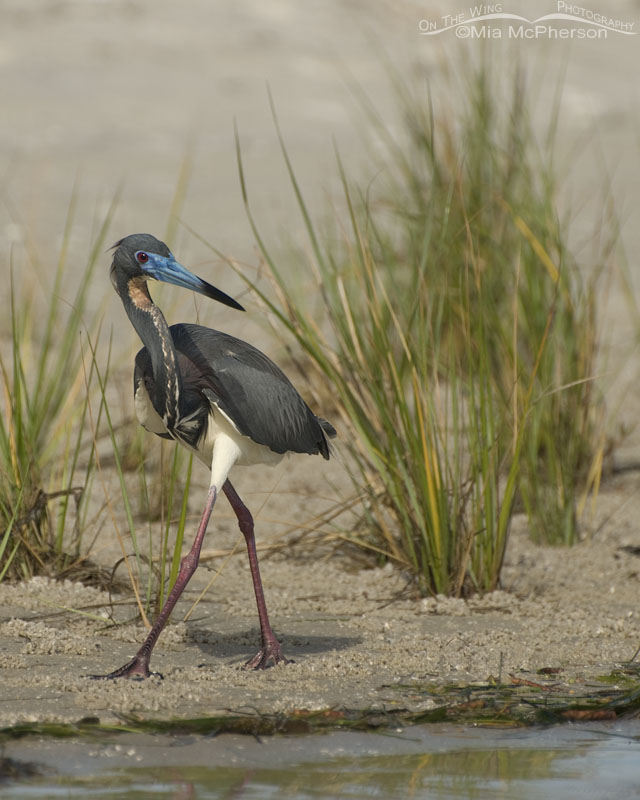When I lived in Florida Tricolored Herons were among my favorite wading birds to photograph and I found them in many different types of habitats. The Tricolored Herons I found there were approachable, interesting and very photogenic.
 Resting Tricolored Heron on the shore of Lake Maggiore- Nikon D70, handheld, f5.6, 1/800, ISO 200, Nikkor 70-300mm VR at 300mm, natural light
Resting Tricolored Heron on the shore of Lake Maggiore- Nikon D70, handheld, f5.6, 1/800, ISO 200, Nikkor 70-300mm VR at 300mm, natural light
I could locate Tricolored Herons at inland lakes and ponds by walking around the shorelines. This one was photographed in 2007 at from the shore of Lake Maggiore at Boyd Hill Nature Preserve where these herons would walk the shoreline in search of prey.
 Tricolored Heron with prey in the waters of the Gulf of Mexico – Nikon D200, handheld, f7.1, 1/750, ISO 200, 80-400mm VR at 240mm, natural light
Tricolored Heron with prey in the waters of the Gulf of Mexico – Nikon D200, handheld, f7.1, 1/750, ISO 200, 80-400mm VR at 240mm, natural light
I also found Tricolored Herons on the shores and beaches of the Gulf of Mexico dashing in and out of the waves while hunting for food. This Tricolored Heron caught a small fish in the waves of Fort De Soto County Park’s north beach in March of 2009.
 Tricolored Heron on the bank of the Hillsborough River – Nikon D200, handheld, f6.3, 1/640, ISO 400, 80-400mm VR at 220mm, natural light
Tricolored Heron on the bank of the Hillsborough River – Nikon D200, handheld, f6.3, 1/640, ISO 400, 80-400mm VR at 220mm, natural light
I could also see and photograph Tricolored Herons along slow moving rivers. This heron was photographed next to the Hillsborough River at a random spot where I pulled over in January of 2009. I noticed that across the river that I could see a rookery, this heron may have nested there.
 Tricolored Heron perched in White Mangroves– Nikon D70, handheld, f5.6, 1/640, Nikkor 70-300mm VR at 240mm, natural light
Tricolored Heron perched in White Mangroves– Nikon D70, handheld, f5.6, 1/640, Nikkor 70-300mm VR at 240mm, natural light
Tricolored Herons are also found in mangrove islands, this one was photographed in June of 2007 as I walked the boardwalk through mangroves at Weedon Island Preserve. This was the first image I ever took of a Tricolored Heron that I was actually happy with.
 Adult Tricolored Heron foraging for prey in a tidal lagoon – Nikon D200, handheld, f6.3, 1/1000, ISO 200, 80-400mm VR at 165mm, natural light
Adult Tricolored Heron foraging for prey in a tidal lagoon – Nikon D200, handheld, f6.3, 1/1000, ISO 200, 80-400mm VR at 165mm, natural light
Tricolored Herons hunt for prey in shallow tidal lagoons too where they are fun to watch and photograph as they run to and fro chasing after their prey. This adult Tricolored Heron was taking a break from hunting when I photographed it in February of 2009 at Fort De Soto County Park.
 Tricolored Heron at Roosevelt Wetland – Nikon D200, on mono pod, f7.1, 1/320, ISO 200, 200-400mm VR at 400mm, natural light
Tricolored Heron at Roosevelt Wetland – Nikon D200, on mono pod, f7.1, 1/320, ISO 200, 200-400mm VR at 400mm, natural light
Wetland habitats were another place where I knew I could usually find Tricolored Herons in Florida. This one photographed in November of 2008 at Roosevelt Wetland in Pinellas County was resting on the surface of vegetation in the water.
 Tricolored Heron in breeding plumage at the edge of a saltwater marsh – Nikon D200, handheld, f6.3, 1/750, ISO 200, Nikkor 70-300mm VR at 300mm, natural light
Tricolored Heron in breeding plumage at the edge of a saltwater marsh – Nikon D200, handheld, f6.3, 1/750, ISO 200, Nikkor 70-300mm VR at 300mm, natural light
Saltwater marshes were terrific for finding and photographing Tricolored Herons, I could usually spot them in the spartina or along the edges of the marsh. I photographed this Tricolored Heron in May of 2009 while sitting in the water just outside of a marsh at Fort De Soto County Park.
It was always great to see and photograph Tricolored Herons in so many different habitats in Florida and I have missed seeing them.
But wandering Tricolored Herons have shown up in Utah and I’d sure love to photograph one here. That would be amazing!
Life is good.
Mia
Click here to see more of my Tricolored Heron photos plus facts and information about this species


Absolutely gorgeous photos! I love the tricolored heron!
Thanks Mia ~
What a wonderful series of shots! I’ve never seen many images of the tri-colored Heron, so this is a special treat. Although, I gotta say the last pic makes me think of the old Tony Bennett song, “Steppin’ Out With My Baby”. Kinda fits doesn’t it? Thanks Mia.
Absolutely beautiful birds! The breeding plumage is something else!
Such stately and beautiful birds.
Many, many thanks.
The Tricolored Herons are so beautiful. Love your photos. Thanks for the posting.
Gorgeous photos.
What a beautiful bird. Especially in its breeding plumage.